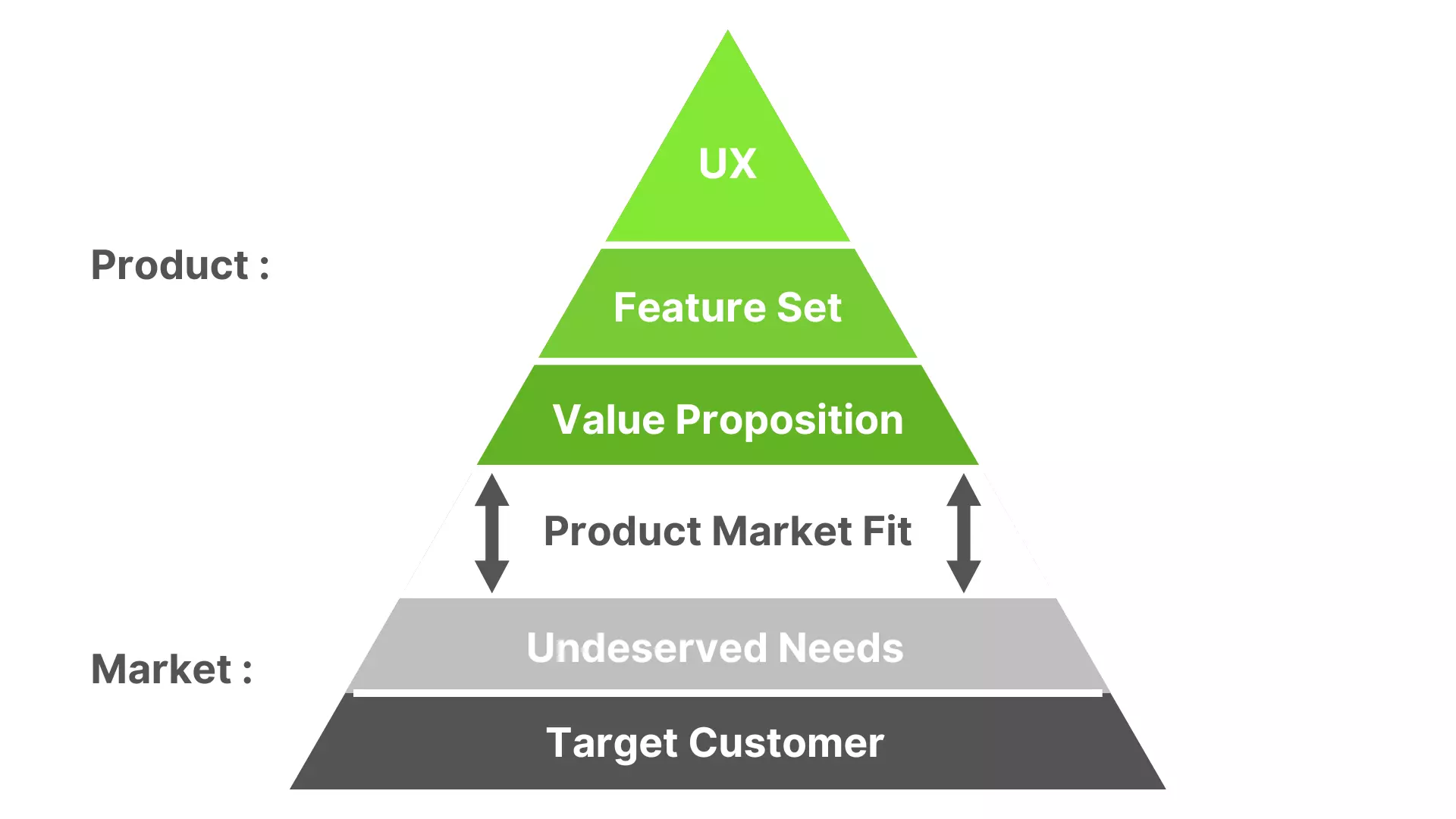Market Fit
Definition
Product market fit is when a product or service satisfies a strong market demand or solves a problem that customers are willing to pay for.
Description
It is a state where a product or service aligns perfectly with the needs and desires of its target market. In other words, the product or service satisfies a strong market demand or solves a problem that customers are willing to pay for.

It is a crucial stage in developing any product or service, as it determines whether or not there is a viable market. Achieving it requires a deep understanding of the target market, including their pain points, preferences, and behaviours, and continuous iteration and improvement of the product or service based on customer feedback and insights.
Importance of Market Fit
Knowing the product-market fit is crucial for the success of any product or service because it helps businesses to:
- Understand their target audience: By identifying the needs and preferences of the target market, businesses can tailor their products or services to meet those needs and preferences.
- Create a competitive advantage: Products or services with a strong market fit have a competitive advantage over those without, as they are more likely to attract and retain customers.
- Increase customer satisfaction: When products or services align with the needs and desires of customers, they are more likely to be satisfied with their purchase, leading to increased loyalty and repeat business.
- Reduce financial risk: Understanding it can help businesses avoid investing resources in products or services that do not have a viable market, reducing the risk of financial loss.
- Drive business growth: Achieving it is a crucial driver of business growth, as it enables businesses to attract and retain customers, increase revenue, and expand their market share.
How to identify a product as a market fit?
Here are some ways to identify if a product is a market fit:
- Customer feedback: The most crucial indicator is customer feedback. If customers are satisfied with the product and willing to recommend it to others, it strongly indicates that the product is a market fit.
- Customer acquisition: If the product attracts new customers consistently and cost-effectively, it shows strong market demand.
- Revenue growth: A product that has achieved it will typically experience revenue growth, as customers are willing to pay for the product or service.
- Market size: If the market size for the product or service is large enough to support sustained growth, it is a good sign that the product has achieved it.
- Competition: If the product competes against similar products in the market, it is a strong indicator that the product has achieved it.
- Repeat customers: If customers are returning to purchase the product repeatedly, it is a sign that the product meets their needs and has achieved it.
Future strategy to develop market fit products.
To develop a suitable market product in the future, businesses can consider the following strategies:
- Conduct market research: Understanding the target market’s needs, preferences, and pain points through market research is crucial to developing a product that meets their needs.
- Iterate and test: Continuously iterating and testing the product based on customer feedback and insights can help to refine the product and ensure that it aligns with the needs and desires of the target market.
- Develop a strong value proposition: Articulating the product’s value proposition and how it addresses the target market’s needs is essential to developing a product with a substantial fit.
- Build a community: Building a community of customers passionate about the product can help drive growth and increase customer loyalty.
- Leverage technology: Leveraging technology such as artificial intelligence and machine learning can help businesses better understand the target market’s needs and preferences and develop products that align with those needs.
- Foster innovation: Encouraging innovation and creativity within the organisation can help businesses develop unique products that offer a competitive advantage in the market.
How to measure product market fit?
Measuring it involves gathering user feedback and data to understand how well the product meets their needs and desires. Here are some standard methods for measuring:
- Net Promoter Score (NPS): NPS measures the likelihood of users recommending the product to others. A high NPS score indicates a strong market fit.
- Customer Surveys: Surveys can gather user feedback about the product, including what they like and dislike about it and how it could be improved.
- User Engagement: Metrics such as active users, time spent on the product, and retention rate can provide insights into how engaged users are with the product.
- User Feedback: Collecting qualitative feedback from users through customer support, user forums, or social media can provide valuable insights into user satisfaction and areas for improvement.
- Sales Metrics: Sales metrics such as revenue, conversion rate, and customer acquisition cost can provide insights into the product’s market fit and potential for growth.
Example:
One example of a brand that achieved product market fit is Dropbox. The company recognized a need for a simple and efficient way for users to store and share files and developed a product that addressed this need.

Through extensive user feedback and iteration, Dropbox was able to refine its product and create a strong value proposition that resonated with its target market. As a result, Dropbox achieved widespread adoption and became a leading player in the cloud storage industry.
FAQs
What is market fit?
It is the degree to which a product or service satisfies the needs and desires of a target market.
Why is market fit important?
Achieving it is important because it determines the success or failure of a product or service in the market. If a product or service does not fit the market, it will not sell well, and the business may fail.
How do you determine market fit?
Determining market fit involves researching and analysing the target market to identify their needs and desires and assessing how well the product or service satisfies them. This can involve conducting surveys, focus groups, and analysing customer feedback.
What are some examples of products that have achieved market fit?
Some products that have achieved market fit include the iPhone, Google Search, and Netflix. These products have all become wildly successful because they effectively satisfy the needs and desires of their target markets.
Can market fit change over time?
Yes, market fit can change as consumer needs and desires evolve, and new competitors enter the market. Businesses must continuously monitor and adapt to changes in the market to maintain market fit.





We would love to have your opinion.